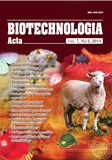ISSN 2410-7751 (Print)
ISSN 2410-776X (Online)

"Biotechnologia Acta" v. 7, no 3, 2014
https://doi.org/10.15407/biotech7.03.060
Р. 60-68, Bibliography 21, Ukrainian.
Universal Decimal classification: 57.086.14; 57.086.18
DETECTION AND CHARACTERISTIC OF FLAT ERYTHROID COLONIES IN SEMISOLID CULTURAL MEDIUMS
1 Institute of Molecular Biology and Genetics of the National Academy of Sciences of Ukraine, Kyiv
2 Institute of Cellular Therapy, Kyiv, Ukraine
3 Institute of Genetic and Regenerative Medicine of the National Academy of Medical Sciences of Ukraine, Kyiv
It have been shown that progenitor cells of cord blood, bone marrow and «mobilized» peripheral blood in semisolid mediums gave flat erythroid colonies. These colonies are able to form one or more red centers on the 14th day of cultivation and get a big size that evidence about high proliferative activity and resemble granulocyte, erythrocyte, monocyte/macrophage, megakaryocyte colony-forming units. However 92% of the cells of flat colonies express CD235. It shows that the colonies are erythroid, although colony morphology differs from burstoforming erythroid units and erythroid colony forming units. Their occurrence probability in methylcellulose-containing medium is 2,5%±1%, that is significantly lower than in agar- containing medium (58%±4,8%). Thus, we suggested that flat colonies should be counted separately or they should be ascribed as BFU-E.
Key words: erythroid colonies, colonyforming activity, umbilical cord blood, placenta, mobilized peripheral blood.
© Palladin Institute of Biochemistry of the National Academy of Sciences of Ukraine, 2014
References
1. Sarma N. J., Takeda A., Yaseen N. R. Colony Forming Cell (CFC) Assay for Human Hematopoietic Cells. J. Visual. Experim. 2010, (46).
https://doi.org/10.3791/2195.
2. Nissen-Druey C., Tichelli A., Meyer-Monard S. Human hematopoietic colonies in health and disease. Acta Haematol. 2005, 113(1), 5–96.
3. Pat. UA 46673 А. Method of the human hematopoietic cells preserving. Lobintseva G. S. Appl. 14.01.2002; Published 15.05.2002, Bull. № 5.
4. Ash R. C., Detrick D. A. Zanjani E. D. Studies of human pluripotential hemopoietic stem cells (CFU-GEMM) in vitro. Blood. 1981, 58 (2), 309–16.
5. Stem cell technology. Identification of Colonies Derived from Human Hematopoietic Progenitors. Manual for using MethoCult. 1–2.
6. Loken M. R., Shah V. O., Dattilio K. L., Civin C. I. Flow cytometric analysis of human bone marrow: I. Normal erythroid development. Blood. 1987, 69 (1), 255–263.
7. Klimchenko O., Mori M., Distefano A., Langlois T., Larbret F., Lecluse Y., Feraud O., Vainchenker W., Norol F., Debili N. A common bipotent progenitor generates the erythroid and megakaryocyte lineages in embryonic stem cell-derived primitive hematopoiesis. Blood. 2009, 114 (8), 1506–17.
https://doi.org/10.1182/blood-2008-09-178863
8. Gaipa G., Coustan-Smith E., Todisco E., Maglia O., Biondi A., Campana D. Characterization of CD34+, CD13+, CD33– cells, a rare subset of immature human hematopoietic cells. Haematologica. 2002, 87 (4), 347–56.
9. Carvalho J. M., Souza M. K., Buccheri V., Rubens C. V., Kerbauy J., Oliveira J. S. CD34-positive cells and their subpopulations characterized by flow cytometry analyses on the bone marrow of healthy allogenic donors. San Paulo Med. J. 2009, 127(1), 12–8.
https://doi.org/10.1590/S1516-31802009000100004
10. Terstappen L. W., Hollander Z., Meiners H., Loken M. R. Quantitative Comparison of Myeloid Antigens on Five Lineages of Mature Peripheral Blood Cells. J. Leukoc. Biol. 1990, 48 (2), 138–48.
11. Antal-Szalmas P., Strijp J. A., Weersink A. J., Verhoef J., van Kessel K. P. Quantitation of surface CD14 on human monocytes and neutrophils. J. Leukoc. Biol. 1997, 61 (6), 721–8.
12. Prokopovych S. K., Vinnitzkiy S. K. Dendritic cells and prospects of their use in immunotherapy of cancer. Oncology. 2001, 3 (2–3), 126–131. (In Russian).
13. Sadahira Y., Mori M. Role of the macrophage in erythropoiesis. Pathol. Int. 1999, 49 (10), 841–848.
14. Van Handel B., Prashad S. L., Hassanzadeh-Kiabi N., Huang A., Magnusson M., Atanassova B., Chen A., Hamalainen E. I., Mikkola H. K. The first trimester human placenta is a site for terminal maturation of primitive erythroid cells. Blood. 2010, 116 (17), 3321–30.
https://doi.org/10.1182/blood-2010-04-279489
15. Grischenko V. I., Lobyntseva G. S., Votyakova I. A., Shereshkov S. I. Fetal liver hematopoietic cells. Kyiv: Naukova dumka, 1988, 192 p. (In Russian).
16. Chena L., Gaoa Z., Zhua J., Rodgers G. P. Identification of CD13+CD36+ cells as a common progenitor for erythroid and myeloid lineages in human bone marrow. Exp. Hematol. 2007, 35 (7), 1047–1055.
https://doi.org/10.1182/blood-2010-04-279489
17. Tepperman D., Curtis J. E. McCulloch E. A. Erythropoietic Colonies in Cultures of Human Marrow. Blood. 1974, 44 (5), 659–669.
18. B?rcena A., Kapidzic M., Muench M. O., Gormley M., Scott M. A., Weier J. F., Ferlatte C., Fisher S. J. The human placenta is a hematopoietic organ during the embryonic and fetal periods of development. Dev Biol. 2009, 327(1), 24–33.
https://doi.org/10.1016/j.ydbio.2008.11.017
19. Serikov V., Hounshell C., Larkin S., Green W., Ikeda H., Walters M. C., Kuypers F. A. Human term placenta as a source of hematopoietic cells. Exp Biol Med (Maywood). 2009, 234(7), 813–23. https://doi.org/10.3181/0809-BC-262. Epub 2009 May 8.
20. Shablii V. A., Kuchma M. D., Kyryk V. M., Onishchenko A. N., Lukash L. L., Lobintseva G. S. Cryopreservation human placental tissue as source of hematopoietic and mesenchymal stem cells. Cellular transplantation and tissue engineering. 2012, 7(1), 54–62. (In Russian).
21. Kuchma M., Shablii V., Kyryk V., Onishchenko A., Shablii Yu., Lukash L., Lobintseva G. Phenotypic heterogenecity of hematopoirtic progrnitor cells from placental tissue compaative analysis with umbilical cord blood and fetal liver. Cell and organ transplantology. 2013, 1(1), 66–69.

